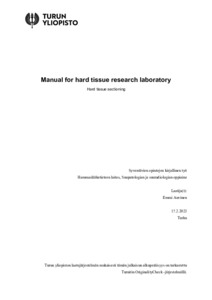Manual for hard tissue research laboratory : Hard tissue sectioning
Auvinen, Emmi (2023-05-19)
Manual for hard tissue research laboratory : Hard tissue sectioning
Auvinen, Emmi
(19.05.2023)
Julkaisu on tekijänoikeussäännösten alainen. Teosta voi lukea ja tulostaa henkilökohtaista käyttöä varten. Käyttö kaupallisiin tarkoituksiin on kielletty.
avoin
Julkaisun pysyvä osoite on:
https://urn.fi/URN:NBN:fi-fe2023052648527
https://urn.fi/URN:NBN:fi-fe2023052648527
Tiivistelmä
Histology is a branch of science that studies different kinds of tissues. In the human body there are four main types of tissues and one of them is called connective tissue. This tissue type includes all the hard tissues of the human body, like bones and teeth. In dentistry hard tissue studies are necessary when examining bones and teeth or for example implant materials. More widely, hard tissue studies have a great meaning in musculoskeletal and material research. Hard tissues consist of minerals from which calcium phosphates are the most important. Calcified tissues are among the most difficult for histological research due to their hardness and they present some special challenges when preparing tissue sections.
The preparation of high-quality hard tissue sections is an extended process which demands some specialized expertise in histological laboratory techniques. Routinely, hard tissue samples must be decalcified to be able to prepare tissue sections. In this process calcium salts are eliminated from the sample by using decalcifying acids like formic acid, or chelating agents, like ethylenediamine tetra-acetic acid (EDTA). However, by using this method the tissue structures may be damaged. When preparing hard tissue sections without decalcifying the tissue in advance, sufficiently low temperatures must be used so that enzyme activity and tissue antigenicity remain immunohistochemically expressible.
In this manual, the most promising way of performing histological hard tissue studies is shown by using Technovit 9100 New embedding method (Heraeus Kulzer GmbH). This method is especially suitable for the studies of bone and teeth. The actual cutting phase is done by using a hard tissue microtome. Sections made by using this method are suitable for different kinds of histological stainings, enzyme histochemistry and immunohistological studies like in situ hybridisation.
The preparation of high-quality hard tissue sections is an extended process which demands some specialized expertise in histological laboratory techniques. Routinely, hard tissue samples must be decalcified to be able to prepare tissue sections. In this process calcium salts are eliminated from the sample by using decalcifying acids like formic acid, or chelating agents, like ethylenediamine tetra-acetic acid (EDTA). However, by using this method the tissue structures may be damaged. When preparing hard tissue sections without decalcifying the tissue in advance, sufficiently low temperatures must be used so that enzyme activity and tissue antigenicity remain immunohistochemically expressible.
In this manual, the most promising way of performing histological hard tissue studies is shown by using Technovit 9100 New embedding method (Heraeus Kulzer GmbH). This method is especially suitable for the studies of bone and teeth. The actual cutting phase is done by using a hard tissue microtome. Sections made by using this method are suitable for different kinds of histological stainings, enzyme histochemistry and immunohistological studies like in situ hybridisation.
